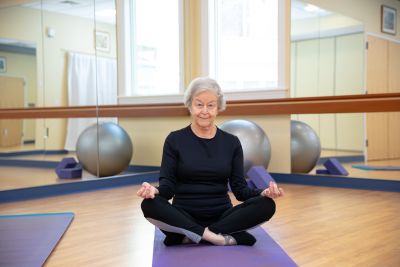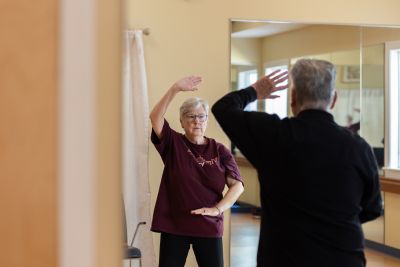 Staying active and maintaining mobility are crucial for seniors who want to live independently and enjoy a high quality of life. Regular movement helps prevent falls, reduces the risk of chronic diseases, and enhances mental well-being. Here are some practical ways we can maintain or improve our mobility as we age.
Staying active and maintaining mobility are crucial for seniors who want to live independently and enjoy a high quality of life. Regular movement helps prevent falls, reduces the risk of chronic diseases, and enhances mental well-being. Here are some practical ways we can maintain or improve our mobility as we age.
Engage in Regular Physical Activity
Exercise is one of the most effective strategies for maximizing senior mobility. Incorporating activities that improve strength, balance, and flexibility can significantly reduce the risk of falls and injuries. Recommended exercises include:
- Walking is a simple, low-impact way to stay active while improving cardiovascular health and leg strength, making it one of the best exercises to improve mobility for seniors.
- Stretching helps maintain flexibility, reducing stiffness and discomfort.
- Strength training. Light weightlifting or resistance band exercises can help build muscle and maintain bone density.
- Balance exercises. Simple movements like standing on one foot or practicing Tai Chi can improve stability.
Prevent Falls With Home Modifications
Falls are a leading cause of mobility issues in seniors. Making small adjustments at home can significantly lower the risk of falls. Steps to take include:
- Installing grab bars in bathrooms and railings on stairs
- Removing tripping hazards such as loose rugs and clutter
- Improving lighting in hallways and staircases to increase visibility
- Using non-slip mats in the bathroom and kitchen
Making these changes can help create a safer living environment and support continued mobility.
Prioritize Joint Health
 Joint pain and stiffness can make movement difficult, but taking care of joint health can help seniors stay mobile. Strategies include:
Joint pain and stiffness can make movement difficult, but taking care of joint health can help seniors stay mobile. Strategies include:
- Maintaining a healthy weight. Excess weight puts pressure on joints, increasing pain and stiffness.
- Eating an anti-inflammatory diet. Foods rich in omega-3 fatty acids, such as salmon and walnuts, help reduce inflammation.
- Staying hydrated. Proper hydration keeps joints lubricated and functioning properly.
- Practicing gentle movements. Activities like swimming and yoga reduce strain while keeping joints flexible.
Maintain Social Engagement
Social activities encourage movement and help seniors stay active, sometimes in ways that don’t even feel like traditional exercise. Whether it’s joining a walking club, participating in dance classes, gardening with others, or simply taking regular strolls with friends, engaging in social movement can help maintain physical function and improve emotional well-being.
Seek Regular Health Check-Ups
Some mobility issues can stem from underlying health conditions such as arthritis, osteoporosis, or neurological disorders. Routine check-ups help detect and manage these issues early. Seniors should consult their doctors about:
- Medication side effects that may affect balance or strength
- Physical therapy options for improved mobility
- Mobility aids for seniors, like canes or walkers, that can enhance safety
Try Mobility-Focused Therapies
Specialized therapies can help seniors stay mobile and reduce pain. Some options include:
- Physical therapy. Tailors care to individual needs to improve strength and balance
- Occupational therapy. Helps seniors maintain independence in daily activities
- Massage therapy. Reduces stiffness and promotes circulation
Consider a Continuing Care Retirement Community (CCRC)
One of the best ways seniors can maintain mobility long-term is by moving into a continuing care retirement community (CCRC). These communities offer:
- Access to fitness and wellness programs. From group exercise classes to swimming pools, CCRCs encourage an active lifestyle.
- On-site medical staff. Having healthcare professionals nearby ensures swift intervention for any mobility concerns.
- Safe, accessible living spaces. Designed with seniors’ needs in mind, CCRCs minimize fall risks through their safety features and systems.
With the right strategies, seniors can maintain their mobility, stay independent, and enjoy an active and fulfilling life. By prioritizing physical activity, making smart home modifications, and considering the benefits of a CCRC, seniors can continue moving with confidence well into their later years.
Stay Active and Mobile With Rappahannock Westminster-Canterbury
Rappahannock Westminster-Canterbury (RWC) is a continuing care community (also known as a life plan community) that provides the highest-quality living experience for discerning senior adults. Situated on 165 beautiful acres outside the village of Irvington in Virginia’s Northern Neck, RWC residents choose to live here for the independent and worry-free lifestyle afforded in a tranquil setting as well as the wide variety of mental health resources.
At RWC, the majority of our residents actively engage in fitness activities at our beautiful Life Enrichment Center. We invite you to take a virtual tour to see for yourself! Our goal is to assist you in living life to the fullest.
Living Well at RWC takes a personalized approach to overall well-being. Our team of health and fitness professionals meets individually with each new resident to develop a tailored wellness program, supporting you in establishing and maintaining a healthy, active lifestyle.
Contact us today for lunch and a tour of our beautiful campus. Alternatively, request a brochure to learn more about living your best life at RWC!
